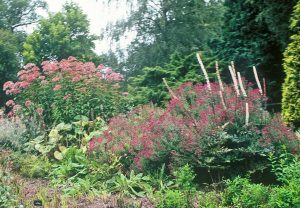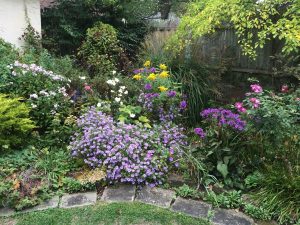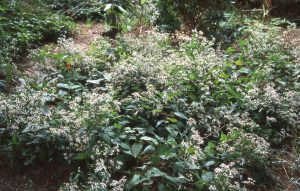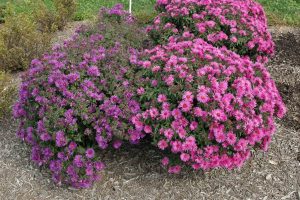
Aster novae-angliae ‘September Ruby’, Eupatorium purpureum and Cimicifuga (Actaea) racemosa combine to create a striking combination in one of the island beds at Bressingham.
Twenty years ago, asters were easy. There were several different species and cultivars. Since then, the taxonomists have been working hard to confuse us. Now, instead of one genus, we have many. The genus Aster now seems to be used exclusively for Eurasian species while our native asters have been divided into several other genii: Symphyotrichum, Eurybia, Doellingeria, and Ionactis, just to mention a few. If we’re confused, pity the home gardener.
The perennial aster, with its many choices of color and height, should be a prominent feature in every fall garden even though many have often been considered merely as roadside weeds. Years of hybridizing, however, have created many cultivars that should be welcome in any garden. Asters should also be considered for home cutting gardens; they are specifically raised in greenhouses for the florist trade.
Aster species are not picky about soil but they must have full sun and adequate moisture to keep reblooming. Some aster species bloom in summer rather than fall but they all have flowers with a daisy-like appearance and alternate leaves.

Aster cordifolius is part of a shrub border that partially screens me from my neighbor.
Aster cordifolius/Symphyotrichum cordifolium (Heart-Leaf Aster) is not well known but I have found it to be a very tough plant. Mine is sited in one of those “Oh, no” sites – waterlogged in spring and like cement in summer as well as only getting water when Mother Nature sees fit. Hundreds of small, pale blue flowers, on five to six foot slender but strong stems, greet the eye in September. The foliage is heart-shaped at the base but lanceolate on the stems. This aster is excellent for flower arranging. ‘Little Carlow’ is a shorter cultivar, topping out at two feet, making it more usable in the perennial garden.

One of my back beds comes into its own in September when the dark purple Aster novae-angliae ‘Hella Lacy’ and the blue Aster oblongifolius ‘October Skies’ vie with the pinks of Anemone japonica and Rosa Oso Easy ‘Happy Smoothie’ as well the yellow Solidago.

Aster oblongifolius ‘Raydon’s Favorite’ partners well with Pennisetum ‘Hameln’ and the foliage of Amsonia ‘Halfway to Arkansas’.
Another little-known species is Aster oblongifolius/Symphyotrichum oblongifolium (Aromatic Aster). This one tends to grow two to three feet high on stiff, hairy stems. The flowers, as one might expect, are lavender with yellow centers. The leaves are fragrant when crushed, thus the common name. It is a very useful perennial for pollinator gardens. I’ve grown ‘October Skies’ in my back garden and ‘Raydon’s Favorite’ in my front garden for several years but find that I need to cut ‘October Skies’ in half in June to keep it from being too tall since it is at the front of that bed.

The multitudinous, tiny flowers of Aster divaricatus appear faithfully every fall regardless of the growing conditions.
One of my favorites is Aster divaricatus/Eurybia divaricatus (White Wood Aster). This aster is incredibly adaptable, willing and able to grow in sun or part shade, average moisture to dry sites under trees. Only twelve inches inch high with heart- shaped foliage that remains evergreen, it becomes eighteen to twenty-four inches when in bloom. Hundreds of tiny white daisies last from September to October and then, with their seed heads, still have an interesting presence in the garden well into the winter.

This aster, ‘Vibrant Dome’, next to its cousin ‘Purple Dome’, has been close to my heart since it suddenly appeared and graced my garden in 1996.
The best known aster is A.novae-angliae/Symphyotrichum novae-angliae, the New York Aster. Usually four to six feet tall, this fall-blooming aster ranges in color from purple and pink to white. There are several excellent cultivars from which to choose. ‘Alma Potschke’ is only four feet but has considerable impact in the garden because of its hot pink flowers. ‘Hella Lacy’ has deep purple flowers on five foot stems while ‘September Ruby’ has ruby red flowers on five to six foot stems. There are several other cultivars but I have not grown them. Two dwarf cultivars are ‘Purple Dome’ which has flowers the same color as ‘Hella Lacy’ and ‘Vibrant Dome’, a magenta sport found in my garden. Both are only two feet high.
These asters need to be grown in lean soil. Highly enriched soil makes the stems lanky and floppy. Even in lean soil, I find it advisable to prune the tall ones as soon as the plants are a foot high. Cutting them in half will make them bushier as well as shorter. Try not to do this later than June 15 or flowering will be quite delayed. Even so, be prepared to use gro-throughs to keep them from falling over when it rains. This species is also a prolific self sower but the seedlings are easy to pull. Be aware that all seedlings of ‘Purple Dome’ and ‘Vibrant Dome’ should be pulled because they will be tall rather than dwarf.
Similar to the New York Aster is Aster novi-belgi/ Symphyotrichum novi-belgi (Michelmas Daisy), the differences being that the flowers have half the number of rays and that the leaves are smooth rather than hairy. There are literally hundreds of cultivars, any of which are an excellent alternative to Chrysanthemums. Most of these asters are short, generally no taller than fifteen inches. The ‘Woods Series’ is particularly good, being mildew resistant.

This a closeup of the flowers of Aster tataricus ‘Jin Dai’.
The last species I want to mention is Aster tataricus (Tatarian Daisy). You will have to spend more energy finding this Eurasian species but it will be worth your effort.. The species is very tall, growing six to seven feet. I’ve had the “dwarf” cultivar ‘Jin Dai’ that only grows four feet in my garden for almost twenty years. The clump has enlarged very slowly but, from time to time, I get out the shovel to contain its spread. It blooms in early to mid-October with yellow centered, lavender flowers. Its serrated foliage is quite large and its stems are so sturdy that they never need staking.
Propagation of aster species should be by division in early spring or fall or by terminal cuttings.
With all of these aster species to choose from, you should be able to find at least one that will work well for you.


1 Comment